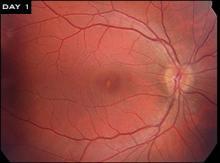
Fundus image of retina with white central scar from solar burn. Image courtesy of R. Couceiro.
A solar eclipse will be visible across North America for 2 to 3 hours on Monday, August 21, 2017. Watching the moon slowly block out the sun is a rare opportunity but should be attempted with caution.
“Never look directly at the sun or an eclipse! The sun’s rays can damage the retina and lead to permanent vision loss,” said Rachel Bishop, M.D., chief of the NEI Consult Service. The retina is the light-sensitive tissue in the back of the eye. A condition called solar retinopathy occurs when sunlight burns and potentially scars the retina. Symptoms of solar retinopathy include central graying and fuzziness of vision.
A solar eclipse can be viewed safely by looking through special-purpose solar filters. These filters must meet an international standard, indicated by ISO 12312-2 certification.
“While using UV-blocking sunglasses is an important part of keeping your eyes healthy, even very dark glasses cannot protect your eyes from damage caused by looking directly at the sun,” Bishop said. Use of regular sunglasses, damaged solar filters, or peeking between your fingers or through a pinhole to watch a solar eclipse is not safe.
“The only safe way to watch a solar eclipse without a filter is by turning your back to the sun and watching a projection. Devices such as pinhole projectors allow you to watch an indirect image, which is safe and still exciting,” explained Bishop.
To learn more about solar eclipses and how to watch them safely visit:
- https://eclipse2017.nasa.gov/safety
- https://www.aao.org/eye-health/tips-prevention/solar-eclipse-eye-safety
- https://eclipse.aas.org/eye-safety
###
NEI leads the federal government’s research on the visual system and eye diseases. NEI supports basic and clinical science programs to develop sight-saving treatments and address special needs of people with vision loss. For more information, visit https://www.nei.nih.gov.
About the National Institutes of Health (NIH): NIH, the nation’s medical research agency, includes 27 Institutes and Centers and is a component of the U.S. Department of Health and Human Services. NIH is the primary federal agency conducting and supporting basic, clinical, and translational medical research, and is investigating the causes, treatments, and cures for both common and rare diseases. For more information about NIH and its programs, visit http://www.nih.gov/.
NIH…Turning Discovery Into Health®